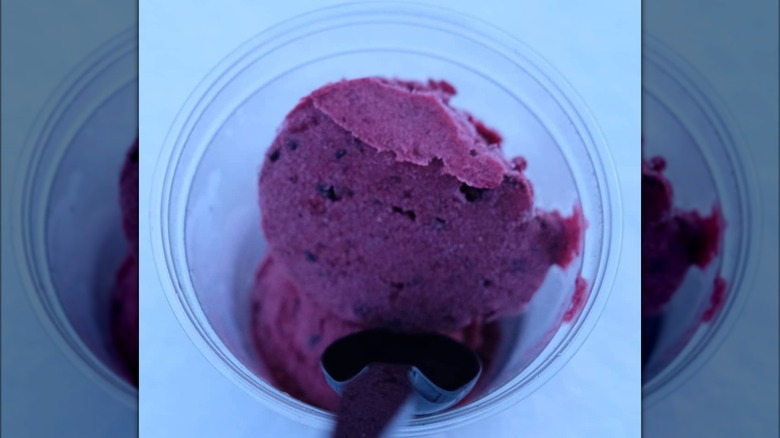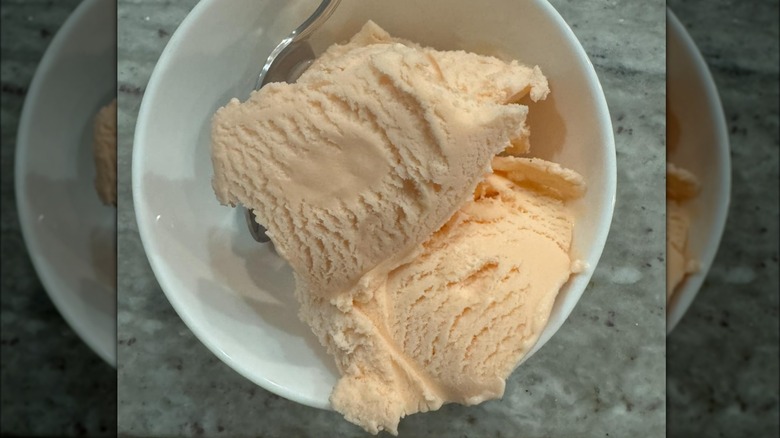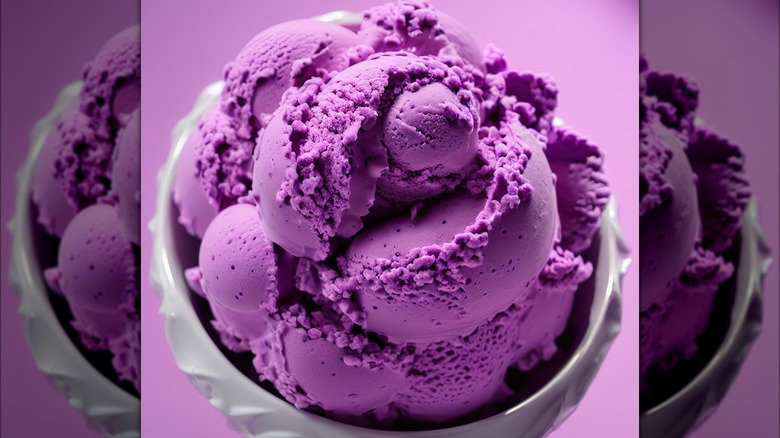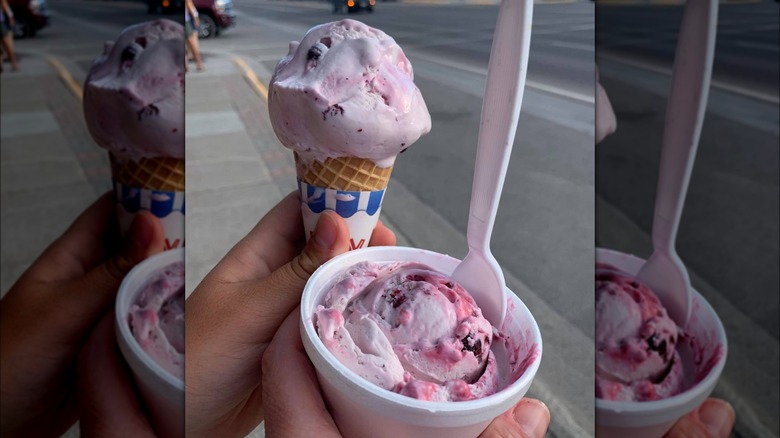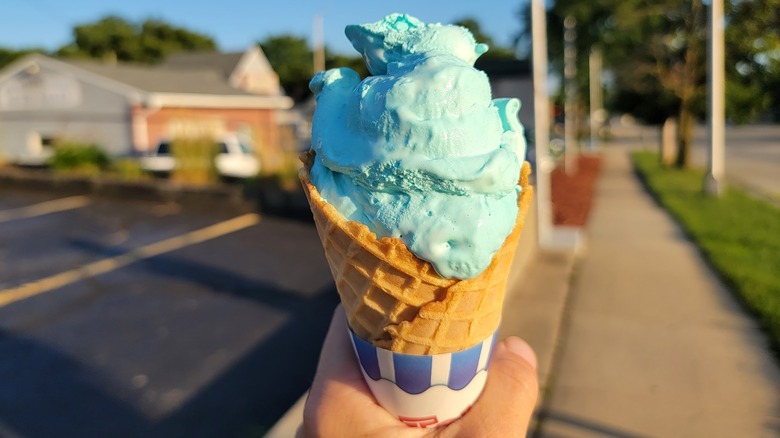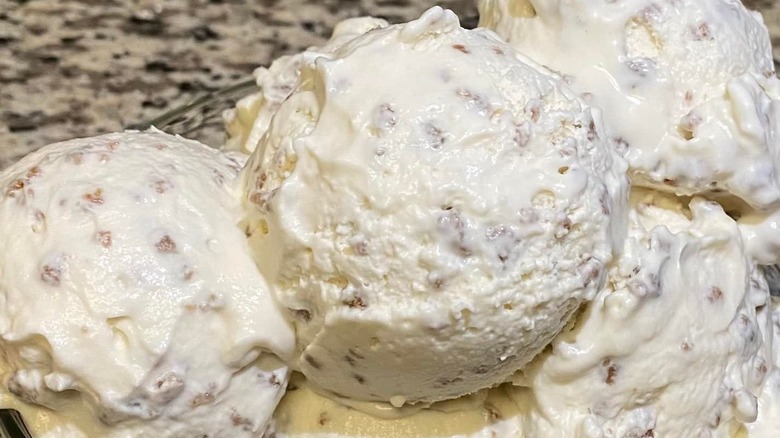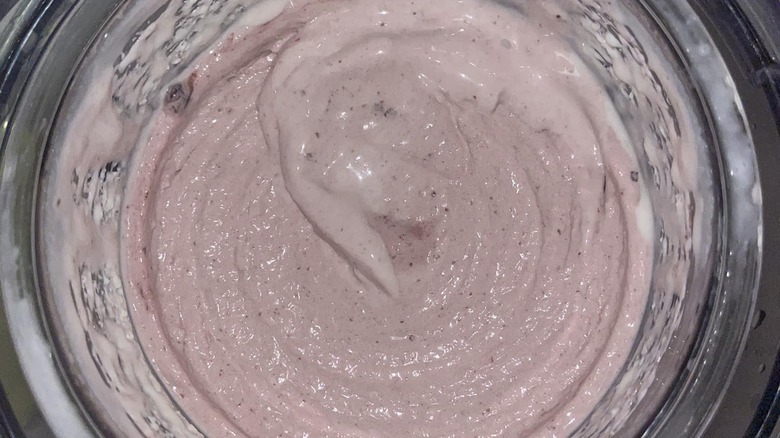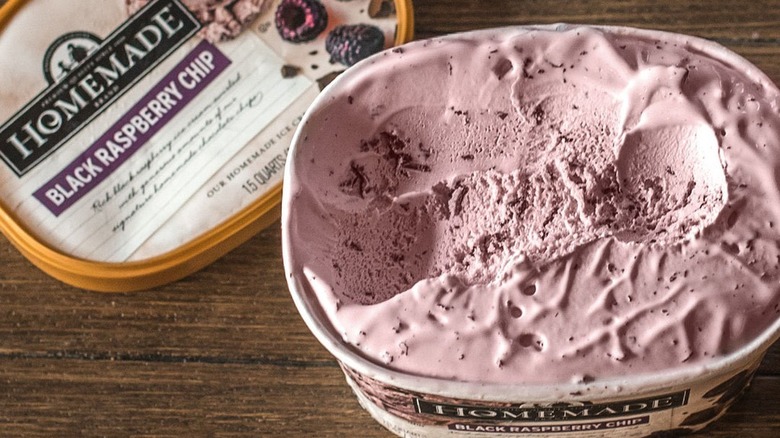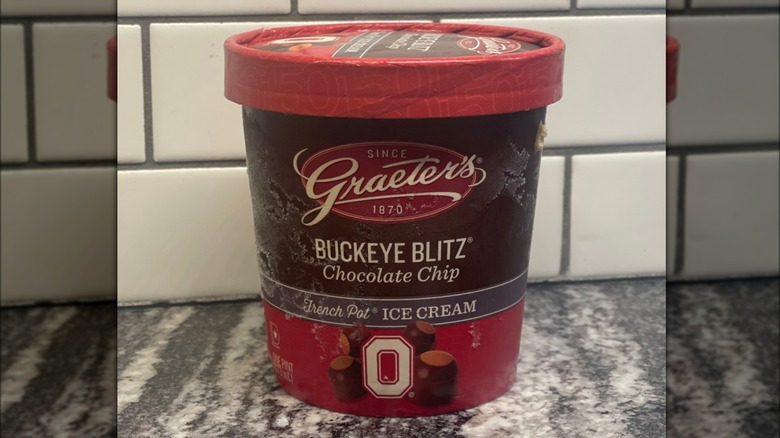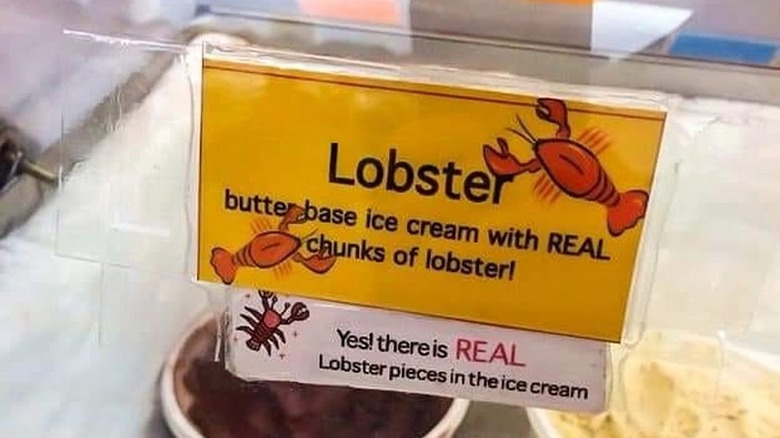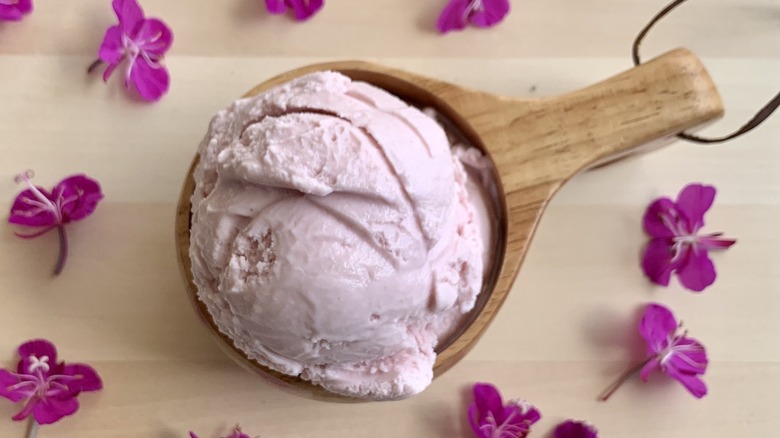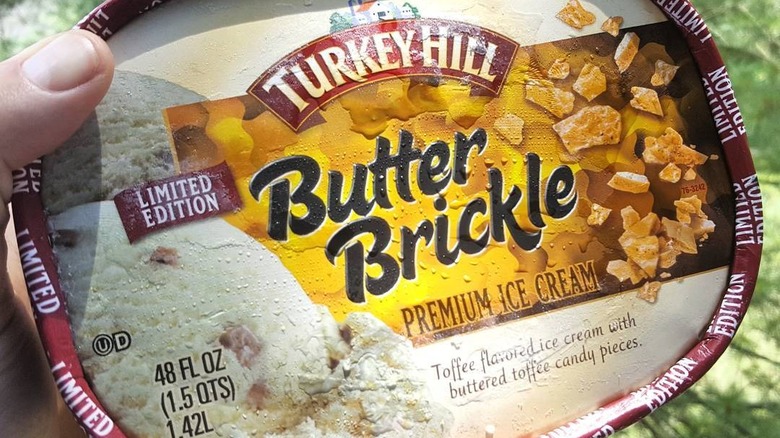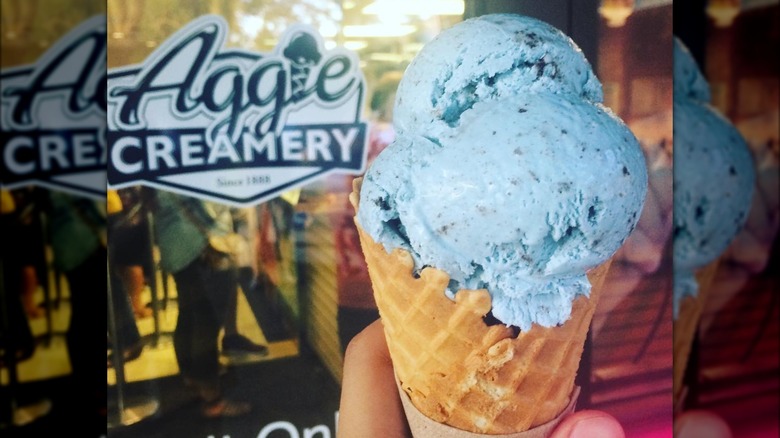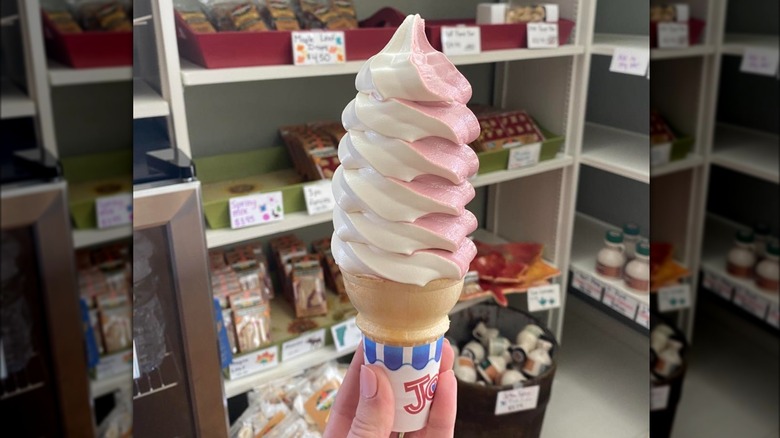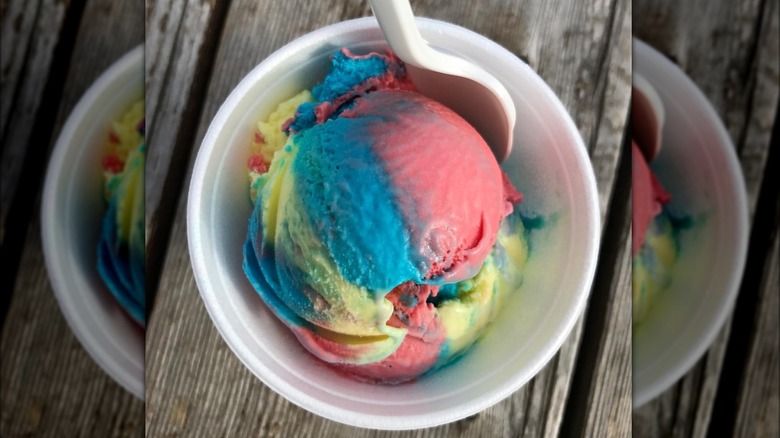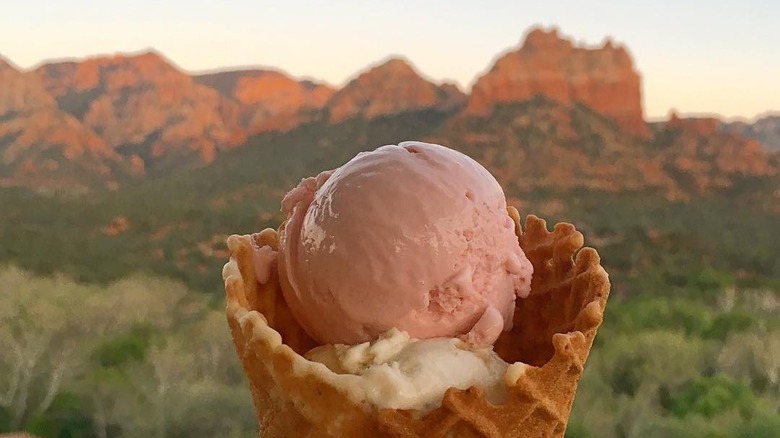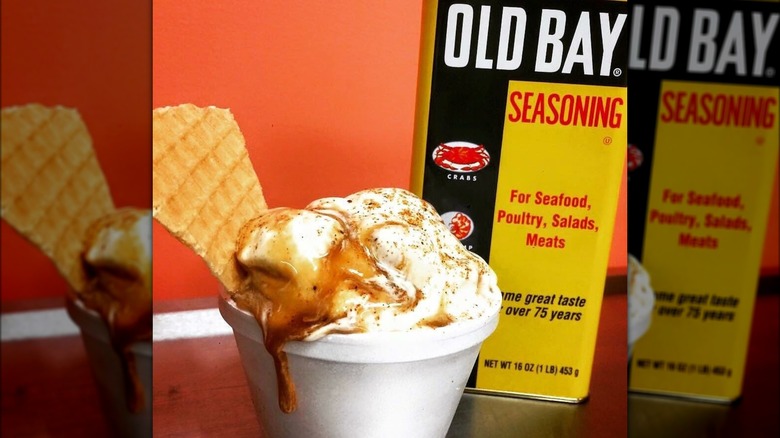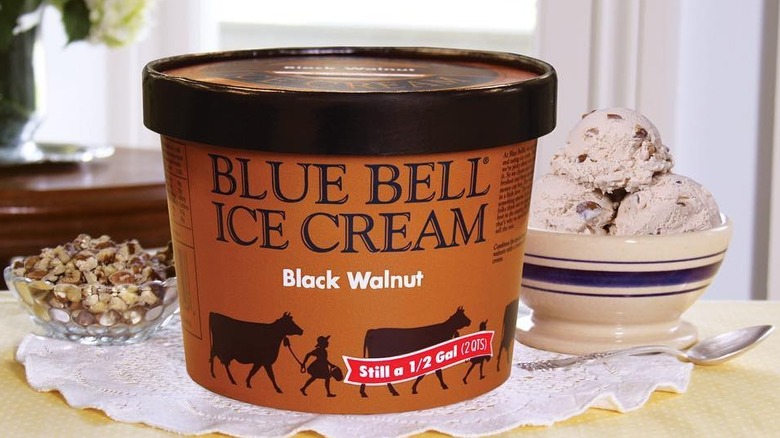18 Uncommon Ice Cream Flavors Across The US
If ice cream is top of mind for you in the summer — or year-round, as it is for about three-quarters of Americans (via YouGov) — chances are you've tried a few flavors in your time. Vanilla and chocolate might still land on top when people answer polls about their favorite, but that's not a reason to limit yourself. Novelty ice cream flavors keep the dessert exciting for experimental palates.
Regions across the U.S. are known for their signature scoop flavor, be it one made from a local fruit or delicacy or the result of various cultural influences. Some have been around forever, it seems, while others have origin stories that are shared from cone to cone. If you consider yourself an ice cream aficionado, there's no doubt you need to find a way to taste as many as possible.
We've collected a list of some of the most uncommon ice cream flavors from across the U.S. that you'll want to try. Some are slowly making their way to neighboring states and surrounding areas, but for the most part, you'll have to plan a tasting journey to try them all.
Akutaq
Ice cream doesn't always take on the mouthfeel you'd expect. If you think it's a sweet and creamy concoction that melts in your mouth, consider this Alaskan variation that goes in a different direction. Alaska's Akutaq ice cream, also called Eskimo ice cream, consists of a unique recipe that might not satisfy everyone's sweet tooth. The treat is made with local ingredients like reindeer fat, seal oil, fresh snow, and berries. Other versions lean toward more savory flavors with dried fish or game.
The components are whipped with air, either by hand or with a mixer, to create a chilled, foam-like texture. Traditionally, akutaq is served on special occasions such as funerals and celebrations. Depending on its particular makeup, it can be enjoyed as a meal, snack, or dessert. Considering the specific ingredients, it's no surprise you haven't come across it at your neighborhood scoop shop. Still, modern renditions call for shortening, sugar, water, and berries, which means you can make it at home — no seals required!
Teaberry
Even avid berry connoisseurs might be unfamiliar with teaberries: a regional plant on the East Coast that also goes by "wintergreen." The plant produces small red berries, but its leaves are equally flavorful and familiar to gum chewers. Pennsylvanians are enamored by the refreshing ingredient and use it in a bubblegum pink-hued ice cream flavor.
The dessert offers a conflicting taste, as it's notably minty and zesty rather than sweet and fruity, as its color might suggest. Although it's still sold in various ice cream shops around the state, some scoop shop owners note that it's not quite as popular as other options, which might be due to the medicinal taste some consumers describe.
Some packaged ice cream producers make the ice cream seasonally, so it's not a ubiquitous flavor on the freezer shelf. Nevertheless, for anyone looking to get a taste of wintergreen mint in a bright pink scoop, teaberry ice cream is the source.
Ube
Purple ice cream isn't always the result of food coloring, at least not when it's made with real ube. These purple yams are pleasantly sweet and earthy, which makes them a great contender for a novel ice cream flavor. Although the practice of using it in ice cream originates in the Philippines, it has since become popular in neighboring countries and made its way to American shores. You'll find it popping up in ice cream shops across the states, including in Hawaii, where ube desserts are ube-r popular. This may be partly due to a Filippino culinary influence, which has been present since migrations in the early 1900s.
Original recipes often had sweetened condensed milk, coconut, and cooked mashed yam, but nowadays, recipes commonly include cream, sugar, and eggs. Aside from infusing your dessert with a bold color and a deliciously nutty taste, mashed ube adds an extra creamy and rich consistency. Some places take a shortcut and infuse ice cream with ube extract, so seek out a quality parlor if you want to taste the real deal.
Huckleberry
North Idaho is home to the first huckleberry ice cream creation, thanks to Van's Creamery. Since its inception in the 1950s, the fruit has been incorporated into dozens of desserts, though arguably none as delectable as the frozen treat. The original ice cream recipe consisted of a swirl of sweet huckleberry syrup and locally foraged berries and was described by the Coeur d'Alene Press as "heaven in a mouthful."
Huckleberry ice cream is also a delicacy in Montana and Utah, where the plant grows in specific conditions at high altitudes. It only grows in the wild, which might explain its near-absence outside of the Northwestern United States. The berry tastes like a cross between other fruits like blueberries, boysenberries, and black cherries, with a greater contrast of sweet and tart flavors. It lends itself well to being combined with classic scoops like chocolate that round it out with richness.
Blue Moon
If you're going to the right scoop shops, you won't be limited to enjoying this flavor once in a blue moon. Blue Moon ice cream originated in Milwaukee and has since spread to other areas of the Midwest. True to its name, this ice cream boasts a bright blue color, though no one knows what the flavor actually is. Eating it evokes many descriptors, including Froot Loops, blue Lucky Charms marshmallows, citrus, bubblegum, cotton candy, almond, vanilla, and spices.
Guess all you want as to what this ice cream is supposed to be because you won't be privy to its true contents — even if you ask. The recipe for Blue Moon ice cream is top secret information, held under lock and key by Weber Flavors. Of course, that doesn't stop people from trying to make it at home, with ingredients like vanilla pudding, lemon extract, raspberry, and sweetened condensed milk. Regional parlors make the flavor by combining Blue Moon flavoring with a neutral foundation, resulting in subtle differences from shop to shop.
Grape-Nuts
Adding cereal to a bowl of milk (or vice versa, depending on your preferred method) is an obvious combination, which makes Grape-Nuts ice cream less of a stretch. Why not transform the breakfast duo into dessert? The Post cereal might not be your first choice when thinking of merging the two, but it turns out its malted barley taste makes a great pairing with vanilla ice cream.
The original recipe likely originated in Nova Scotia, Canada, and spread throughout the Northern Atlantic states. You'll find it most often in Maine and other states in the New England area, but it will also pop up in the Carolinas and the Midwest. The cereal-based flavor is also popular among the Jamaican population in the U.S. and is often found in neighborhoods with Caribbean influences. Grape-Nuts is a cheaper alternative to regular nuts and infuses flavorful notes and crunchiness — especially if the cereal is coated with sugar before being mixed with the vanilla cream base.
Marionberry
Marionberries are a specialty in Oregon, so we won't blame you if you've never heard of them. As you might imagine, this berry is closely related to other berries — most notably blackberries. The Marionberry was initially created in Marion County, Oregon in the 1950s by crossing Chehalem and Olallie blackberries. Consequently, it looks like a blackberry and tastes a bit sweeter, balanced with hints of acidity and earthiness. The seeds are subtle on the palate, and the fruit is extra juicy. As you can imagine, these traits make it great for an ice cream.
Marionberry ice cream is similar to blackberry, yet the extra sweetness and succulence give the flavor more intensity. The fruity element pairs with a creamy base for a scoop that highlights seasonal produce at its finest. Considering their limited growing season and small harvest area relative to more popular berries, securing a scoop of marionberry ice cream has the added appeal of relative rarity.
Black raspberry
There are far more berries out there than the average supermarket carries, and black raspberry is one example you may have imagined was just that — imaginary. The uncommon berry grows freely in some parts of New England and commercially in the Pacific Northwest for only a few months of the year. You might be wondering how black raspberries differ from blackberries. Simply put, the former is smaller and more delicate, with a hollow center just like its rosy counterpart.
The small berries pack in a punch with an intensely sweet taste and a juicy bite. Subtle woodsy notes evoke their wild nature, making them feel like a step up from ordinary raspberries. Since they're only at their peak for a short duration, it's a limited offering at artisanal ice cream parlors and is often mixed with dark chocolate chips. That said, select manufacturers like Graeter's stock it year-round, so you can satisfy your craving if you know where to shop.
Buckeye Blitz
If you're familiar with buckeyes, the fudgy peanut butter and chocolate confection, then you're just a step away from Buckeye Blitz ice cream. This tantalizing flavor brings everything we love about the magical pairing of peanut butter and chocolate into one luscious scoop.
This Ohio favorite is trademarked by the Graeter's Ice Cream Company, which sells Buckeye Blitz chocolate chip ice cream in a pint-sized format. The flavor consists of chocolate-infused peanut butter ice cream woven with chunks of peanut butter cookie dough and dark chocolate chips. The result is smooth and unctuous, with chewy and crunchy bites that surprise your palate.
The flavor is so connected to Ohio that the company rebranded the packaging for its 150th anniversary, in collaboration with The Ohio State University, which was celebrating the same birthday. Aside from commemorating overlapping timelines, the university's mascot is Brutus Buckeye, making this flavor the perfect match for the partnership.
Lobster
Although it's unexpected at any ordinary parlor, if you're in Bar Harbor, Maine, lobster ice cream isn't that far-fetched. Considering that the state hosts a yearly lobster festival, lobster ice cream is just one more addition to the lobster-filled euphoria. You're likely to get a scoop if you attend the festival, but a surefire way to savor the creative combination is by going to the shop that started it all at the end of the '80s: Ben & Bill's Chocolate Emporium.
Cooking lobster with butter and cream is natural, and indeed, the sweet meat lends itself well to rich textures and flavors — including the ones found in vanilla ice cream. Chunks of frozen cooked lobster meat mingle with the chilled treat, which is served in a cone for extra crunch or in a cup to fully savor the flavors. Some people liken it to frozen lobster bisque, which is a pretty close association considering the components. Although it's not everyone's favorite, there's definitely an allure to tasting lobster ice cream in none other than Maine.
Fireweed
If you enjoy scattering edible flowers on your salads, fireweed ice cream should be the next flavor you pursue — and you can add the petals to salads, too. This wildflower, which gets its name for its ease of growing in fire-ravaged soils, has a beautiful magenta hue that makes for a whimsical scoop beloved by all ages. Although the wild plant can be found in many states, most people just see it as a flower, whereas Alaskans turn it into dessert.
One shop in Anchorage, Wild Scoops, is especially known for its delicious fireweed ice cream. It's the store's most popular flavor in the summertime, and it's only part of the lineup when the flowers are in bloom. The taste is very much what you'd expect from a flower, but the sweetness isn't over the top, thanks to a floral profile that keeps every mouthful pleasant and light.
Butter Brickle
For some people, the classic candy behind this ice cream flavor is a trip down memory lane. Butter Brickle is a Nebraskan confection with a texture similar to Heath bars. It became a frozen dessert in the 1920s thanks to the Fenn Bros. Ice Cream and Candy Company. The treat features a vanilla ice cream base with pieces of crunchy, buttery toffee often coated in chocolate. To double down on the buttery aromas, Butter Brickle ice cream may contain butter-flavoring as well as pure butter.
The company responsible for bringing us this delectable candy was sold in the '70s and eventually purchased by Hershey's over 20 years later. Nowadays, a few companies like Bruster's, Braum's, and Turkey Hill produce ice cream bearing the Butter Brickle name, though the namesake candy brand no longer exists. That said, if you're craving the sugary dessert, you could set about making Butter Brickle ice cream from scratch.
Aggie Blue Mint
Blue mint isn't just any ordinary mint option. It was one of the winners of a 2004 ice cream flavor competition run by the Aggie Creamery at Utah State University. It was among hundreds of flavor ideas that were narrowed down and tested by food science students.
The Blue Mint flavor (originally named Aggie Iceberg) calls for peppermint essence and blue food coloring to give it a vibrant hue. To add even more visual appeal, the students decided to combine the blue cream with chunks of chocolate cookies and white chocolate, adding a delicious bite and chocolate taste to complement the minty freshness.
The flavor continues to excel among customers and has even been featured in a Crumbl cookie – since Logan, Utah, is the brand's hometown and home to Utah State. It's also still a mainstay at the Aggie Creamery where you can stop in for a scoop or two.
Maple creemee
It's no surprise that a state known for its maple syrup and dairy production would take advantage of this combination and use it to make decadent ice cream. For those unfamiliar with this style of ice cream, it's important to note that a maple creemee doesn't quite follow the proportions of standard ice cream or soft serve, leaving it in a category of its own. Its history isn't totally clear, but it seems to have been introduced to the Green Mountain State in the early '80s.
The creemee, which is served in a dazzling swirl shape, is a favorite in Vermont. You'll find it in ice cream parlors, farmer's markets, and pop-up stands. At its purest, this flavor just consists of maple syrup combined with cream. Of course, you can always emphasize the maple element by garnishing the cone with maple sugar or maple caramel to double down on the flavor. Or, get it blended with other creemee flavors like black raspberry for an especially delicious treat.
Superman
This flashy scoop, named after its Superman-inspired colors, might not give you superpowers, but it will wow your palate with three different flavors. Whereas some multicolored ice cream merely displays different hues, this popular Midwestern dessert boasts three flavor experiences. They aren't always the same across parlors, but they're distinct from each other, which simplifies the decision process if you're looking for variety. The original version traces back to Stroh's Brewery in Detroit, which made the treat in the 1920s during Prohibition.
At the time, it included lemon, Red Pop (a local soda), and Blue Moon, the latter two being regional flavors that elude residents from most other states. Variations exist across local scoop shops, with flavors like black cherry, vanilla, and blue raspberry among the trio's contenders. Vanilla ice cream can be dyed with food coloring for an easy fix, but the real deal features unique flavors. You'll also come across Scooperman, Super Coop, and Super Rainbow varieties — which are all just trying to be Superman.
Prickly pear
Prickly pears are indeed prickly, but their pear qualities merely refer to their shape. The cactus fruit might be a total pain to process, but its sweet taste rewards those who try. Even simpler, find yourself a scoop of prickly pear ice cream or sorbet to get all the taste with none of the hassle. Although the cactus is particularly prevalent in Mexico, there's plenty of it to go around in Arizona, where locals transform it into a multitude of dishes — including ice cream.
The flavor of prickly pears is hard to pin down, but it has similarities to pineapple, watermelon, raspberry, cucumber, and bubblegum. Using them in a frozen dessert is a great way to highlight their fruity notes and take advantage of their juicy texture. Lime juice is sometimes incorporated into the recipe to balance the sweetness of the ripe fruit, so you can expect balance with every bite.
Old Bay
It might not be the ingredient you'd think of reaching for to garnish a scoop of plain vanilla, but Old Bay seasoning is a favorite topping for some folks. You probably won't see this combination much outside of Maryland where the spice blend was created, but it has its fair share of local fans — and you might be inclined to join them. The product ingredient list includes celery salt, paprika, mustard, pepper, and assorted spices, which make for an unexpected yet remarkable pairing with ice cream.
Warming spices, like cinnamon, cloves, and others, are used in baking all the time, so the idea of sprinkling Old Bay on your cold ice cream isn't far off. The contrasting salty, spicy, and sweet notes make for a dessert that is as complex as it is flavorful. Plus, the delicate crystals of salt-infused spices mingle with vanilla ice cream, adding a crunchy note before melting away.
Black walnut
There are various types of walnuts, including this dark variety. Black walnuts aren't as common as the English variety you'll typically find in stores, so be sure to seek out a producer that guarantees the source of the nuts so that you can taste the real deal. Compared to English walnuts, this variety has a more pungent aroma with earthy notes that make the nutty flavor stand out.
Black walnut ice cream can be a bit intense for more delicate palates, but the rich cream base and add-ins like maple syrup round out the flavor and leave a fragrant result. Crunchy bits of nuts add an interplay of textures that keep every mouthful a pleasant surprise. Blue Bell Creameries sells black walnut ice cream in some regions, and once upon a time, Häagen-Dazs did too. Harvesting the nuts is a messy affair, but if you live in parts of the Midwest where they grow in the wild, take advantage of this one-of-a-kind nut and whip up a batch of homemade ice cream.

